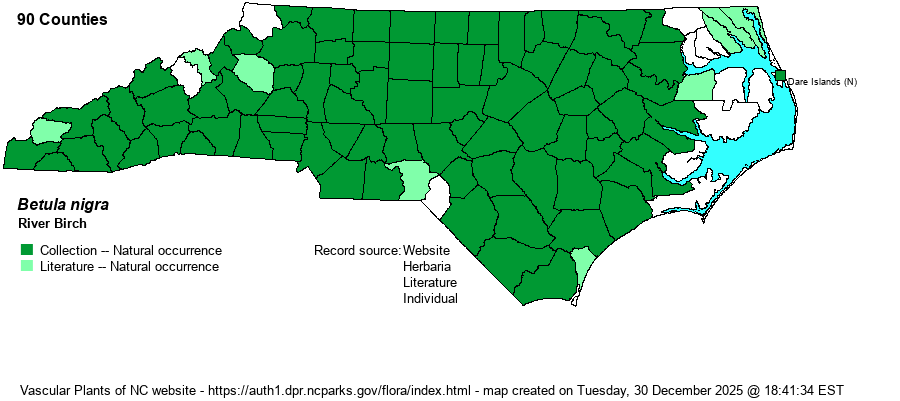| Author | L. | |
| Distribution | Nearly throughout the state, but absent in some far eastern counties (north and south of Albemarle and Pamlico sounds). Also scarce to absent in some Mountain counties, especially the northern Mountains.
This is a species of the Eastern U.S., not quite ranging into Canada. It occurs from southern NH south to northern FL and eastern TX.
| |
| Abundance | Common over essentially all of the Piedmont; common in the western and central Coastal Plain, but generally scarce in coastal counties, especially so in the northeastern counties. In the Mountains, it is uncommon to fairly common in low elevations in the southern counties, but is rare to absent in the northern mountains. | |
| Habitat | This is the only wetland species of birch in the state, occurring essentially in bottomlands, river banks, wet thickets, brownwater swamps, and other damp ground, including sandbars. It sparsely occurs in uplands, mainly in drier portions of floodplains. It is a characteristic early succession tree species of floodplains, along with American Sycamore (Platanus occidentalis), Black Willow (Salix nigra), Sweetgum (Liquidambar styraciflua), and a few others. Though it does reach the canopy, it is not typically a species of mature or old-growth floodplain forests. |
| Phenology | Flowers in March and April, and fruits in May and June. | |
| Identification | This is a medium to rarely large tree, growing to an average height of 60-70 feet tall. It has the shaggiest bark of any Piedmont or Coastal Plain hardwood, as its light gray to light buff-gold bark shows strongly curled, peeling plates. The leaves also differ from other birches and all other trees in our area. They are triangular-ovate and have strong teeth on the margins; they grow to about 2-3 inches long. Thus, this tree should present few identification issues due to its somewhat triangular, toothed leaves and its quite curled/peeling pale bark. | |
| Taxonomic Comments | None
| |
| Other Common Name(s) | Few others in regular use | |
| State Rank | S5 | |
| Global Rank | G5 | |
| State Status | | |
| US Status | | |
| USACE-agcp | FACW link |
| USACE-emp | FACW link |

